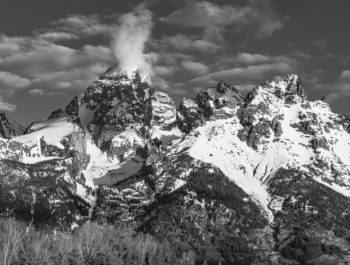Creating Artistic Photographs Film to Digital Paradigm Shift: Part 1
The true mystery of the world is the visible, not the invisible.
Oscar Wilde
Preface
This essay is about the shift from the film paradigm to the digital paradigm in landscape photography. It starts with remarks about my personal experience, continues with a discussion about paradigms in general, and eventually discusses the film to a digital paradigm shift.
If this was a book there would be no purpose for this preface. Book readers expect writers to take their time getting to the subject. However, this being an online essay there is an assumption that the writer will get to the point right away. Therefore I am adding this preface to let you know that I will talk about photography.
Introduction
When I was in graduate school working as a graduate teaching assistant while studying for my Ph.D. in rhetoric there was a lot of talk about paradigm shifts. At that time I taught English 101 and the paradigm shift meant shifting from the three parts essay format –introduction, body, and conclusion– to a free-form essay format that followed the student thinking rather than a stilted and predictable structure. To prove this point in class I asked students to write an essay about X then replace X with any issue they wanted using the search and replace function in their word processor. Written as X the three parts essay meant writing an introduction in which the student said “in this essay, I will show why doing X is bad for you. X can hurt your health, it is illegal and your parents are against it.” The body expanded on the three points stated in the introduction. The conclusion restated the introduction verbatim the only variation being that it was written in the past tense: “in this essay, I showed why X is bad for you. X is bad because… “ Replacing X by a current issue chosen by the student –such as seat belt laws, drug use, political issues, and so on—it did not require changing the structure of the essay. The format worked no matter what the issue was. All that was needed was doing a search for ‘X’ and replacing X by the issue of their choice.
My point here is not to teach you how to write an essay or how to argue successfully about past or current issues. My point is that paradigms often hide a stilted approach to a specific practice. The three-paragraph theme is a solid way of writing. However, it is a pre-constructed formula that students could manipulate using search and replace to ‘write’ essays which, while they met class requirements, required little or no thinking on their part. In other words, students could complete the requirements successfully without reflecting on the issues they were writing about or without sharing a personal position. They could complete the assignment with the least amount of personal involvement and in the shortest time possible by turning in cookie-cutter papers that taught them little about critical thinking, or reflecting on an issue, or sharing one’s personal beliefs.
However, paradigms do change. The end of the three-paragraph theme was a case in point. At English staff parties, we danced what we called ‘the paradigm shift tango.’ It was silly but it provided relief from teaching 101 classes in which our name was spelled ‘staff’ and for which we received little or no respect from students. It was also evidence that the paradigm shift was real. This was a celebratory dance because a paradigm change happens rarely. There must be a reason for the change either a new technology, a new way of thinking, or a new way of doing things. For this reason, paradigms do not change often, once in a generation maybe, or once in a hundred years, or even longer than that. When they do change the event must be celebrated and made memorable in some way.
The change from an old to a new paradigm never takes place smoothly. While the new paradigm offers an updated approach, the old paradigm holds on because it is accepted by people who are familiar with it and use it successfully. Above all, it holds on because those who use it forgot, or never knew, that there are other ways to do the same thing. They have come to believe, after doing something the same way for years, that this is the only way it can be done. Why should they change? Why should they relinquish a system that works and provides expectably results for an unproven approach that may not work as well? For a system that may not bring success, be popular or even be effective? It is simpler to stay with what works. As they say: if it works, don’t fix it.



What Is A Paradigm
For the sake of clarity, it is best to define what is a paradigm before going any further. Wikipedia defines a paradigm as being ‘the philosophical and theoretical framework of a scientific school or discipline within which theories, laws, generalizations and the experiments performed in support of them are formulated.’ Merriam-Webster makes things simpler by defining paradigm as ‘a philosophical or theoretical framework of any kind.’
To put it simply a paradigm is a school of thought. Basically, it is a way of thinking and doing things. Photography has had several paradigms. The two I focus on here are the film paradigm and the digital paradigm.
Habit Creates and Solidifies Paradigms
If I leave the salt and pepper shakers long enough in a specific spot on my kitchen table I will come to believe that they belong there, that this is their designated location and that there is no better place to store them. It may take weeks, months or years but eventually, they will own this spot. I will forget that there are other places to store them. I will not think that I could put them in a closet after each meal for example. The location of the salt and pepper shakers will be turned to stone. It will be unchangeable. I will have come to believe, unconsciously of course, that these two items have to be there. Even though there is nothing easier than picking them up and moving them to another location, I will not think of doing so. This will be their spot, their designated location. This is where they will live. It will not be possible to change this. In fact, the idea of moving them will not even cross my mind.
This is bad when it is applied to the objects we use in our lives. However, it is even worse when it is applied to the ideas we follow in our lives. Just like objects can become stuck on a table forever because we forgot that we have the power and the freedom of moving them at any time, ideas can become stuck in our minds because we forgot that we have the power and the freedom to change them at any time.
Paradigms apply to both objects and ideas. Both can get stuck and both can be changed. Objects can be moved. Ideas can be changed. The old can take place for the new, be it a new place where I keep the salt and pepper shakers or a new approach to the way I create photographs. Paradigms come and go. While they seem to be there forever their presence is actually temporary. We have the power of changing them, whoever we may be. Nothing has to be the way it is now forever.
The reason to change is that old paradigms do not necessarily work. Or rather they no longer work. They show signs of aging. They are outdated. Persisting in using them means missing opportunities offered by new technologies, new ways of thinking, and new ways of doing things.

From Film To Digital
Directly relevant to the subject of this essay is the fact that the practice of photography is controlled by paradigms. These paradigms have changed over the years, from the day photography was invented until today, but they have always been there in one form or another. In other words, photographers believe there is a ‘proper’ way of doing things when it comes to photographing things and representing them in images. This ‘proper’ way is defined by the paradigm that controls the medium at any given time.
I started my photography career using film, then moved to film scans optimized on a computer and finally to a fully digital workflow using digital capture, processing, and printing. This means that I followed two different paradigms during my time in photography: first the film paradigm and second the digital paradigm.
The film paradigm was controlled by the rigid nature of film and darkroom technology. Film had a narrow dynamic latitude making exposure critical. Darkroom processes were limited to controlling tonality, color balance, and cropping. The shape of the elements in a photograph could not be changed, external elements could not be added and photographs could not be easily combined. Doing color developing and printing at home was severely limited due to the complex equipment and chemical processing involved. For this reason, color processing was best left to professional labs.
Coming from a painting background, having just completed studies at the Beaux-Arts, the severe limitations of film made photography a rigid medium when compared to painting. However, I did not let that stop me. I read every book on the subject. I used the zone system. I built a home darkroom. I followed Ansel Adams’ developing and printing workflow. I was a good student.
Despite all my efforts, I was never satisfied with my film photographs. My black and white prints always came out too contrasty. I learned later on, by comparing darkroom prints to digital prints of the same images, that I was using paper one grade too high. I should have used grade 2 instead of 3. Unfortunately, I figured that out too late. My color prints did not please me either. I loved color but despite my attempts using home-based Cibachrome kits the results of my color printing efforts were unsatisfying.
The rigidity of film photography was frustrating. It did not let me do what I wanted to do. Having started my fine art career as a painter I found film limiting. Film controlled me far more than I controlled it. I had to do what it asked more than I could ask it to do what I wanted. Digital photography changed all of that. I jumped in immediately because digital offered so many advantages. Not only could I do all the things I wanted to do but could not do with film, I could also do things I had never thought of doing. Furthermore digital was a flexible medium that kept improving as new cameras and new software became available.
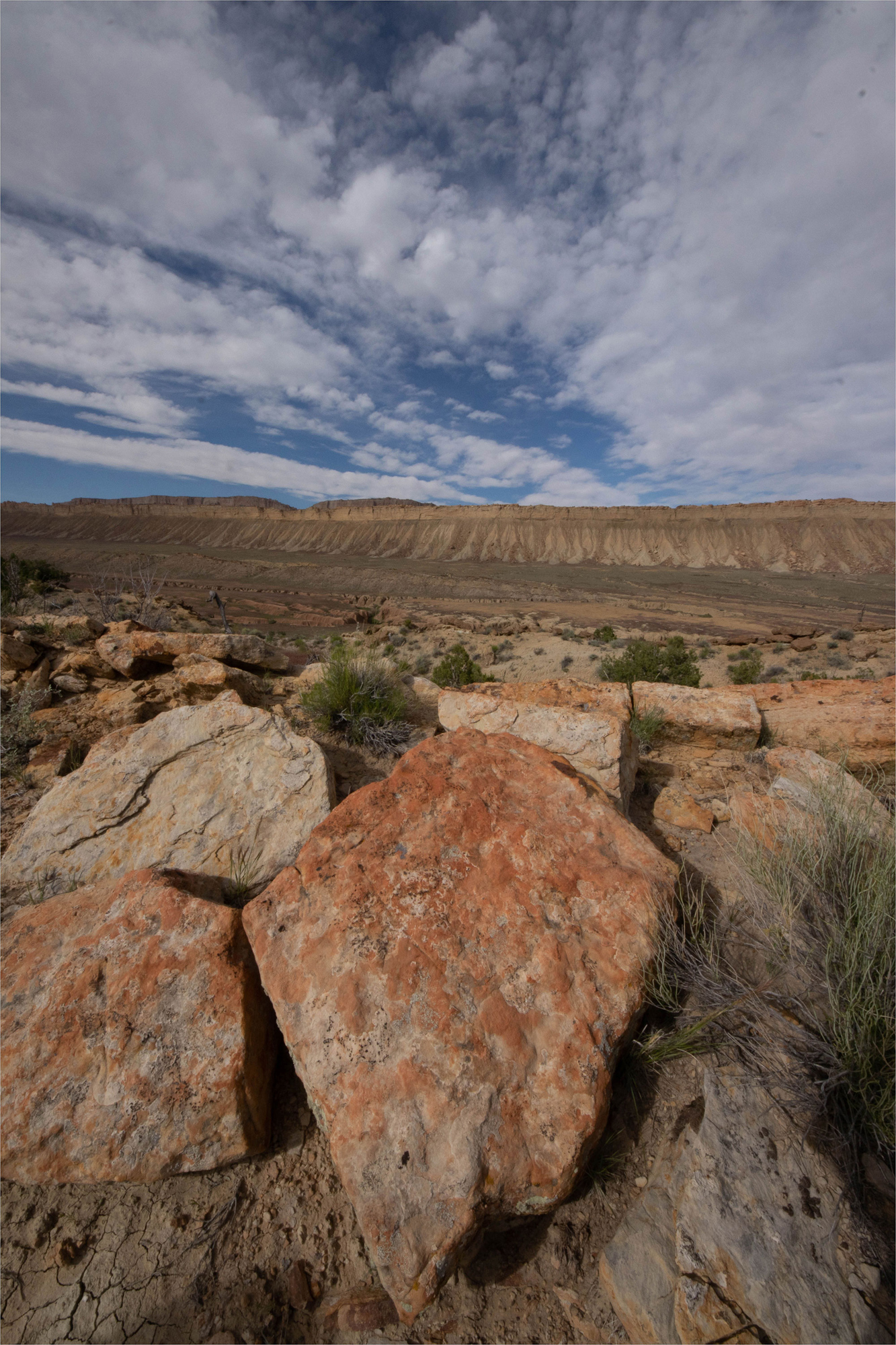
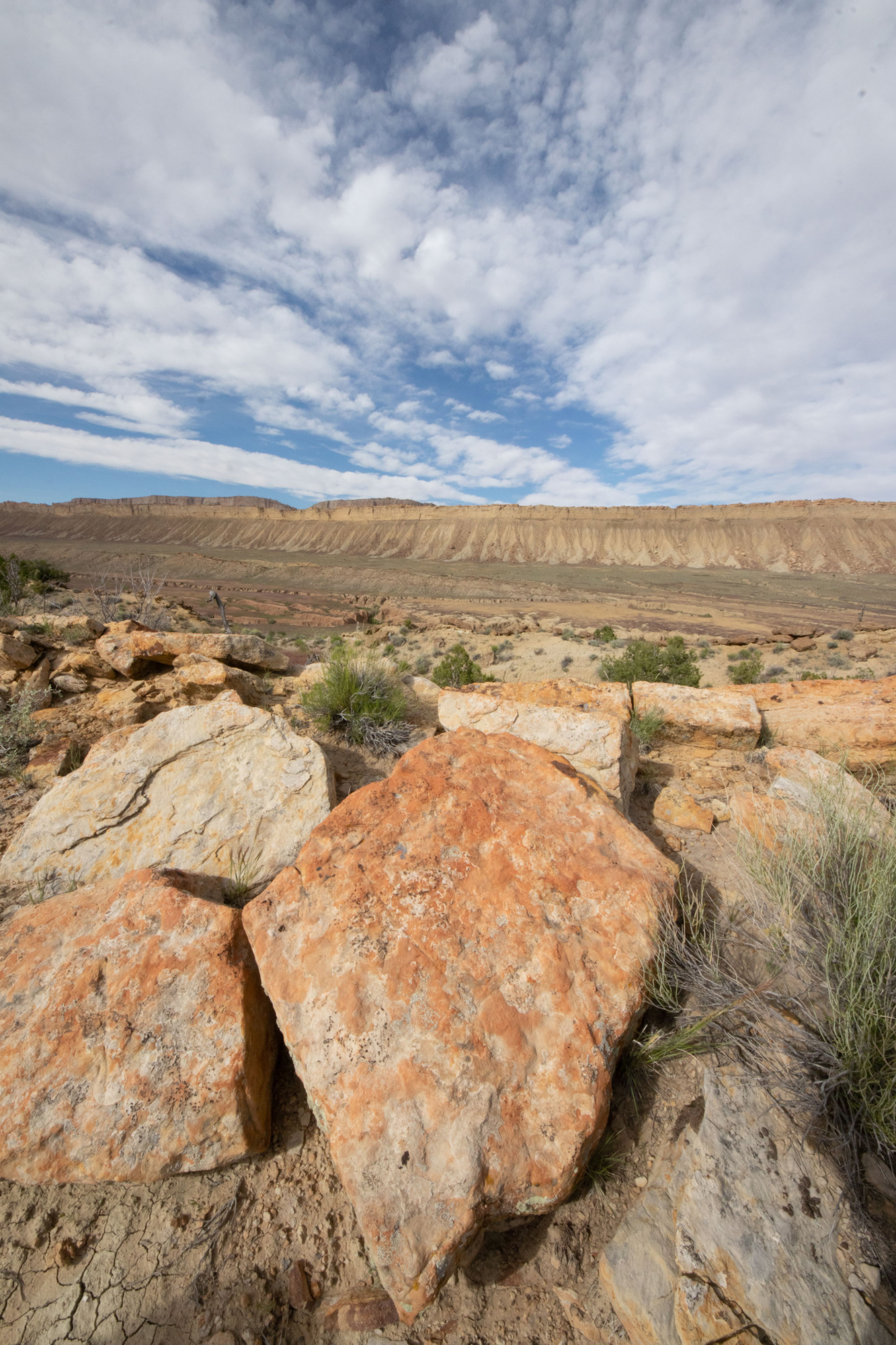
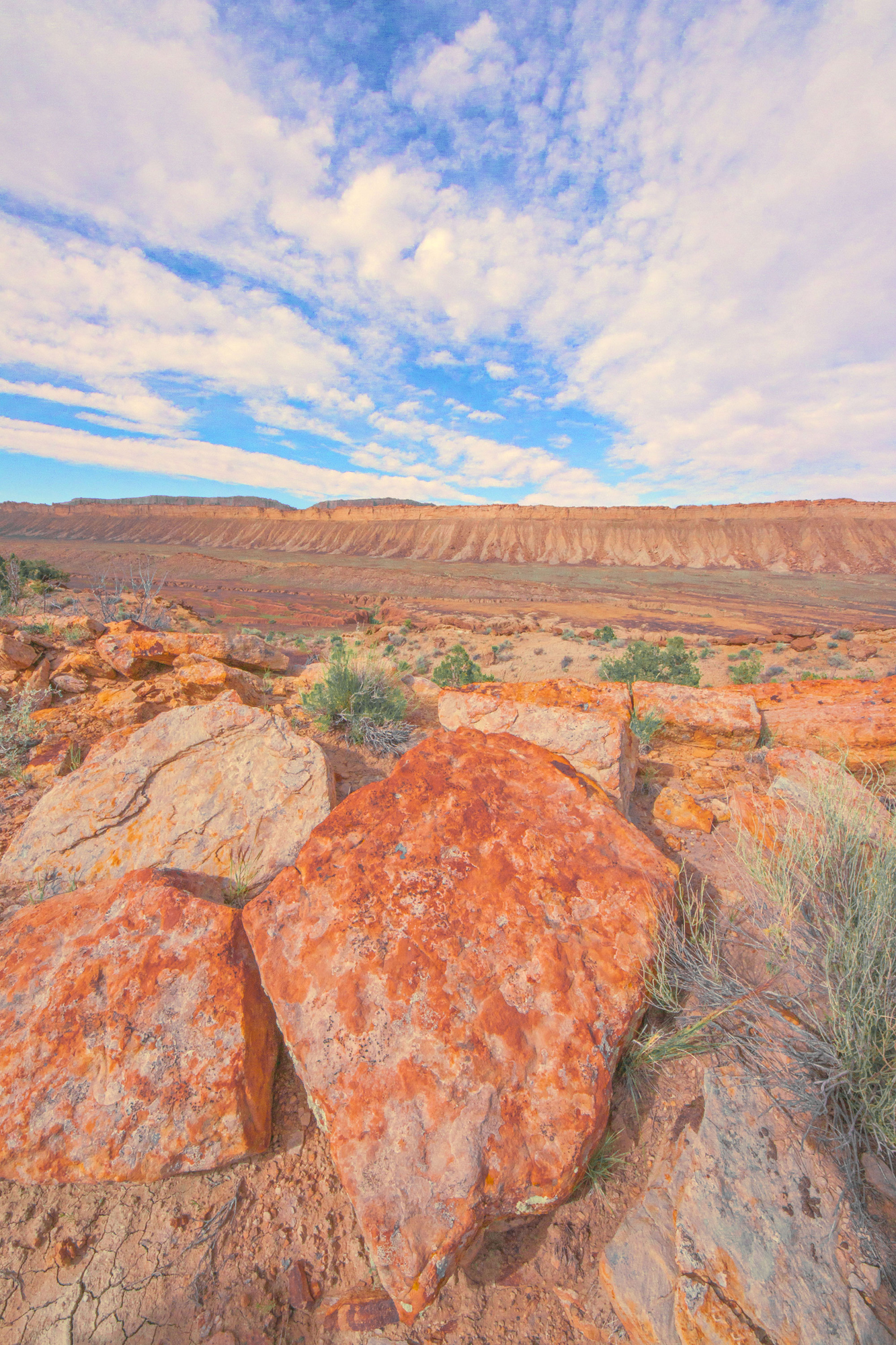
The future looked bright. I embraced the new paradigm and explored the new possibilities it offered. Doing so allowed me to expand my artistic universe and reach new artistic frontiers. I purposefully set it as a goal to go further and further with my work by letting go of the constraints imposed by film. The exploration of these new possibilities was a transitional period in my work. It represented the change from one artistic approach to another.
In regards to my audience, the consequences of shifting from film to digital were mitigated. It brought praise from the forward-looking part of my audience and criticism from the conservative-minded part of my audience. Dealing with praise was easy. I just needed to say ‘thank you.’ Dealing with criticism was more difficult. I needed to know what to say and when a situation is new figuring out what to say is challenging. This often means trying different responses until an effective answer is found. Sometimes it means not responding. Often it means finding a simple response, one that does not require a lengthy explanation and that can be grasped quickly and unmistakably by my interlocutors. It also means doing all this without sounding rude.
One of the most challenging questions was being asked if I manipulated my work. At first I did not know what to say and fell all over myself giving endless and useless ‘explanations’. It took me a long time to figure out that the best answer was a simple yes. The key to finding this answer was understanding that customers who accosted me with ‘Do you manipulate your work?’ had no intention of buying anything. They wanted to see how I would respond to what was a potentially insulting question. After answering with a simple ‘Yes’ I would wait to see if they came up with a response. Most customers did not. They took my answer as it was intended: a straightforward response to a straightforward question. It was such a breakthrough that I wrote an essay, Just Say Yes, to explain the reasons behind my answer.
Business, Competition, and Paradigm Shift
This rift in my audience was not lost on my competitors. They capitalized on my customer’s fear of what was then a new process. They told customers that my photographs were manipulated, that the prints would fade, and that my photographs did not show something real.
This worked to some extent because digital photography was unknown to my customers. They were unsure of its investment value and it did not take much to turn their lack of knowledge into fear of buying. I did not let that deter me. I hired an expert to teach me salesmanship so I would not have to reinvent the wheel, and learned how things are sold and why people buy art. I learned how to turn objections into advantages by countering every objection with a positive counter objection. I learned that when a customer says no to a closing attempt this is a starting point and not the end of the selling process. I learned that most of my sales were made to people who first said no and that it often took four or more closing attempts before making a sale. This gave me another advantage over my competitors because most of them never studied salesmanship.
Shifting to a digital business approach had more advantages than disadvantages. At the time I was making all my income from print sales. My competitors used film and had their prints made by commercial labs. To get the lowest price on prints they had to make large quantities, hundreds or thousands at once. Printing digitally myself meant I could make just one print of each image because my cost was the same whether I made one print or one hundred prints. Digital printing also shortened the time required to make prints because I could do it in my studio instead of having to ship transparencies to a lab and wait for the lab to ship me back prints.
The speed with which I could go from taking a photograph to making a print was a major advantage. Going from image capture to final print could be done in a couple of days. This meant I knew if a new photograph was popular with my clients within a week or two. I would test the market by making single copies of new photographs quickly and in single copies. If these new images sold I would print more in increasingly larger sizes. If these new images were unpopular I would discontinue them. This shortened the time necessary to find bestsellers. Film processing was so slow that it took years for my competitors to get the same information.


Business Advantage and Guilt
Put together these aspects of the digital paradigm gave me a massive business advantage. It kept my costs of production low. It shortened my production times. It cut off the middleman by making print suppliers unnecessary. It gave me more time for market testing. All this meant I moved forward faster than if I had stuck to film.
While I did lose some sales to my competitors because they played up customers’ fear of the digital process, I still made out better than all of them. Within two years I was outselling, and more importantly out-profiteering, photographers who had been in the business 15 years longer than me. Some of them were shocked because they had been selling at the same show for years and had never seen anyone move up that quickly.
On the negative side, I must say that I experienced guilt when I first switched from film to digital. This guilt came from trying to adhere to the parameters of the film paradigm. I enjoyed the freedom that digital gave me because I could do anything I wanted with my images. However, I did not want to say this out loud to my audience because I felt guilty about the artistic freedom that this change gave me. Unconsciously I believed photography should be difficult and that as a photographer my creative freedom should be limited.
The outcome of this mixed set of emotions is that I felt guilty about telling my audience that I sold digitally enhanced photographs. I did not lie when I was asked but I did not promote it when I was not asked.
I experienced guilt because I believed I had to maintain adherence to a paradigm that no longer worked for me or met my needs. Today the fear of being accused of manipulating is gone because people understand that the digital paradigm is about manipulating. The guilt is also gone because I fully embrace the digital paradigm.
Conclusion
What would my photographs be without the possibility of modifying what the camera captures? Can I go back to processing film and printing images in the darkroom? Can I fall in love with the smell of chemicals once again? Can I get used to working in the dark or under a yellow light? Can I cope with not being able to look at unexposed printing paper in daylight? The answer is no. Digital photography spoiled me. It also spoiled many other photographers. Even though some refuse to fully embrace the digital paradigm, they have been spoiled by it to the point of no return. What they resent is not the digital paradigm as a whole. What they resent are specific aspects of this paradigm. The manipulation possibilities for example. The ease with which we can take photographs today. The high dynamic range and high-resolution cell phones can create photographs as good as a 4×5 if printed in moderate sizes. They resent that but love everything else.
As with most paradigm shifts the transition is uneven, hectic, filled with emotion, and replete with careful personal positioning. However in the end the shift cannot be avoided. Shifting to the digital paradigm is as inescapable as upgrading a computer to the new operating software. There is only so long one can hold back until making this shift is unavoidable. New software and hardware demand it. Clients ask for it. The industry is moving on. The world is changing and we need to change with it or become dinosaurs, as likely to become extinct as the Brontosaurus or the Diplodocus. When necessity calls we must respond and this response takes the form of accepting the new paradigm in an ever more complete manner.
To Be Continued
The film paradigm is still deeply entrenched in the photography world. Today many digital photographers continue to use a film based paradigm either in whole or in part. This is a complex issue, one that deserves to be covered separately, which is what I will do in my next essay.
About Alain Briot
I create fine art photographs, teach workshops with Natalie and offer Mastery Tutorials on composition, image conversion, optimization, printing, business, and marketing. I am the author of Mastering Landscape Photography, Mastering Photographic Composition, Creativity and Personal Style, Marketing Fine Art Photography, and How Photographs are Sold. All 4 books are available in eBook format on our website HERE. Free samples are available so you can see the quality of these books for yourself.
Find more information about our workshops, photographs, writings, and tutorials as well as subscribe to our Free Monthly Newsletter on our website. You will receive 40 free eBooks when you subscribe.

Studying Fine Art Photography With Alain and Natalie Briot
If you enjoyed this essay you will enjoy attending a workshop with us. I lead workshops with my wife Natalie to the most photogenic locations in the US Southwest. Our workshops focus on the artistic aspects of photography. While we do teach technique, we do so for the purpose of creating artistic photographs. Our goal is to help you create photographs that you will be proud of and that will be unique to you. The locations we photograph include Navajoland, Antelope Canyon, Monument Valley, Zion, the Grand Canyon, and many others. Our workshops listing is available HERE.
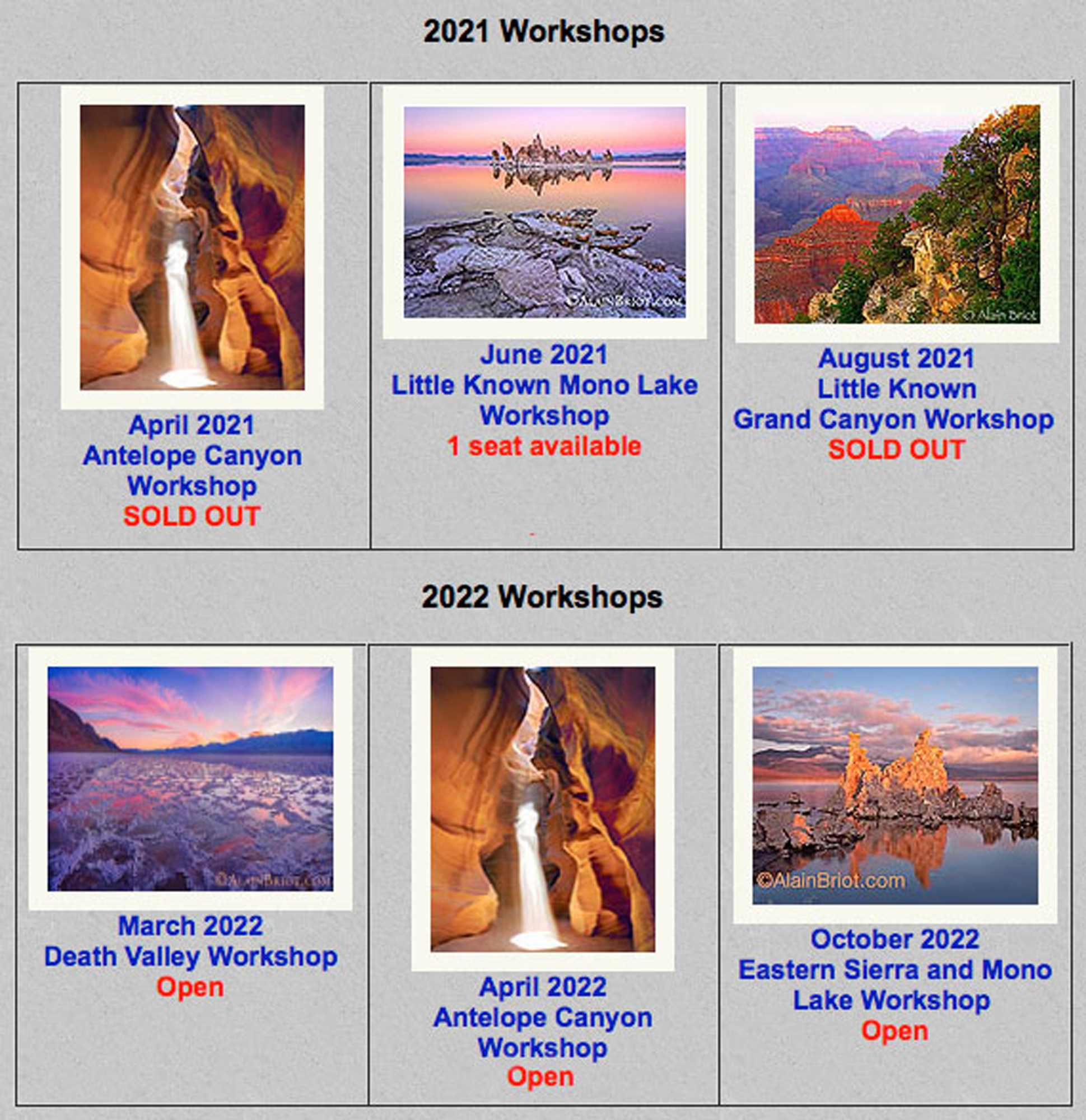
Alain Briot
April 2021
Glendale, Arizona
Author of Mastering Landscape Photography,Mastering Composition, Creativity and Personal Style, Marketing Fine Art Photography, and How Photographs are Sold. http://www.beautiful-landscape.com [email protected]




